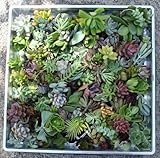Prickly Pear Cactus 15 Seeds - Mixed Opuntia Species
Feature
- The name Opuntia comes from the name of a Greek city
- Prickly pear branches (the pads) are also cooked and eaten as a vegetable
- Hardiness zones 9-11
- Opuntia grow best where they receive at least 4 hours of sunlight daily
- 15 Seeds
Product Detail
- ASIN: B002PYMKCK
- Item model number:
- Average Customer Review: Customer Reviews
Product Description
They grow in sections, any of which can be removed and rooted to start a new plant. The pads are actually modified branches or stems that serve several functions: water storage, photosynthesis and flower production. But members of the Opuntia genus are unique because of their clusters of fine, tiny, barbed spines called glochids. Found just above the cluster of regular spines, glochids are yellow or red in color and detach easily from the pads.
Opuntias often have large, colorful flowers. The fruits of most prickly pears are edible and sold in stores under the name "tuna." Prickly pear branches (the pads) are also cooked and eaten as a vegetable. They too are sold in stores under the name "Nopalito."
Hardiness zones 9-11, (-5°C/25°F, 4°C/40°F). In the spring and summer the soil should become fairly dry between waterings. The plant should be given a deep drink at this time, to the extent that the water runs out the bottom of the pot. In winter, it is best to water only enough to keep the plants from shriveling. Opuntia grow best where they receive at least 4 hours of sunlight daily, but they will grow fairly well in bright indirect light indoors. In the spring and summer, Opuntias prefer night temperatures of 65°F to 70°F and daytime temperatures of 75°F to 85°F. Use a normal cactus soil.





